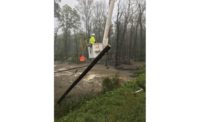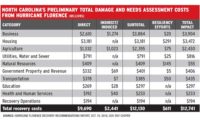Hurricane Florence's Approach Has Contractors Scrambling
A major wind and rain event expected to affect a vast region

PCL Constructors expected to complete by Tuesday afternoon the removal of all marine equipment from the navigation span of the Herbert C. Bonner replacement bridge over Oregon Inlet, N.C., for either staging in adjacent waters or relocation off site in preparation for the approaching storm.
Photo courtesy of PCL Constructors
With Hurricane Florence gathering strength on a projected track toward the North Carolina coast, state agencies and contractors are preparing not only for 130-mph winds and storm surges, but also for protracted rainfall and inland flooding.
 |
Expected to make landfall near Wilmington, N.C., on Friday morning, Florence has spurred government-mandated evacuations of coastal areas from Virginia to South Carolina, which triggers emergency traffic-management adjustments. On Tuesday morning, SCDOT officials reversed the eastbound lanes of I-26 from Charleston to I-77, providing extra capacity for Low Country residents leaving the area. West Virginia has also suspended construction work on I-77 to facilitate evacuations and delivery of relief supplies. NCDOT's ferry system has assisted with moving residents and visitors off isolated Ocracoke Island, among the most vulnerable of the state's barrier islands.
At a Tuesday afternoon press conference, North Carolina emergency officials reported that FEMA will use Fort Bragg as a staging area for its response effort. NCDOT will coordinate the use of drones for areal monitoring and inspections as the storm unfolds.
NCDOT also ordered contractors with projects that may be in the path of the hurricane to secure any equipment or materials against high winds.
"In locations that have concrete barriers in place on travel lanes, they are to make sure that all drainage systems are clear," adds agency spokesperson Steve Abbott.
Near Wilmington, Balfour Beatty has already removed much of its equipment from the nearly completed, 65-ft-tall Topsail Island Bridge in Surf City. Construction has been on track to wrap up later this month.
Related Articles
Carolinas Brace for Coastal Erosion, Storm Surge
And Heavy Rains as Hurricane Nears
Nuclear Plants, Utilities Prepare For Florence
"As the bridge structure and deck is complete, there's not much else we can do," says Balfour Beatty spokesperson Christy Barger. She speculates that the new 0.9-mile bridge could be pressed into service as a viable evacuation route should Florence compromise the existing swing-span bridge that it will replace.
Further north on the North Carolina coast at the Herbert C. Bonner Bridge replacement project at Oregon Inlet, PCL Constructors expected to have completed its preparations by midday Tuesday. According to company spokesperson Heather Yount, "All marine equipment is being removed from the navigation span and either staged in adjacent waters or relocated off-site, while cranes will be boomed down and secured and all materials will be tied down and/or relocated off-site."
Yount says the last closure of the 2.8-mile-long bridge's segmental units in the span that rise 70 ft above the inlet's navigational channel was completed this summer. The bridge is scheduled to open to traffic in December.
Stall Over the Carolinas Anticipated
Over the weekend, Florence is expected to weaken and stall over the Carolinas, a scenario that could result in rainfall amounts of a foot or more across the state and up into Virginia, where areas already are saturated by an unusually rainy summer.
In-progress highway projects vulnerable to flooding and erosion include the 16-mile Maysville Bypass in Maysville, N.C., and the 26-mile I-77 P3 toll lanes corridor in Charlotte, which experienced rainfall-related drainage issues earlier this summer.
Jane Leier, spokesperson for I-77 Mobility Partners, explains that the problems occurred in an area of intense construction activity near the city's central business district. Sugar Creek Construction, the project's construction manager, and NCDOT have since adjusted erosion control and drainage systems to help move runoff more efficiently.
"We also have a maintenance contractor on standby during the storm in case problems reoccur," Leier adds.
Another concern are the rains' effects on several coal ash storage ponds owned by Duke Energy, which is in the midst of a multiyear program to clean up contamination around the sites. Bloomberg news reports that while the company has set up monitoring operations at five storage basins near the coast, several facilities located inland could be vulnerable to leaks or structural failure depending on rainfall amounts.
Drainage issues and rapid response to fallen trees and power lines are also among the Virginia DOT's priorities. An agency spokesperson says the five-mile I-64 widening near Richmond and other in-progress worksites are being stabilized in preparation for winds and heavy rain. VDOT has also lifted work zone lane closures on major routes, where possible, to keep roads clear for emergency responders and possible evacuations.
At the Chesapeake Bay Bridge Tunnel, where excavation recently began on a launch pit for a tunnel-boring machine that will build a new one-mile parallel tube at Thimble Shoals, the Dragados/Schiavone Construction-led team is implementing a severe-weather plan that includes moving small equipment and supplies from work areas on the artificial islands, located approximately 3.5 miles offshore, and tying down and securing all larger equipment.
"Due to the size of the plant and equipment required to support the project, it is not practical to demobilize all equipment and supplies," explains Michael Crist, the Bridge-Tunnel authority's deputy executive director for infrastructure. Crist expects the jobsite to secured by midday Wednesday.
Tower Crane Removed
Balfour Beatty also removed a tower crane at the site of the Lake Kilby Water Treatment Facility improvements project in Suffolk, Va.
Florence's impending arrival has forced contractors to scramble in other ways. JE Dunn had planned an intricate concrete slab pour for the stage and auditorium at the new Stono Park Elementary School in Charleston, S.C., on Wednesday. Facing an evacuation order and the concrete subcontractor's plan to have its trucks off the road by mid-morning Tuesday, the project team acted quickly to expedite the pour so that completed work could be saved before winds and rains arrived.
"The team worked together to pull it off," says JE Dunn senior project manager Bryan Ferris, "and still allowed to folks to get home and take care of their families before evacuating."




